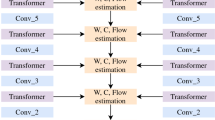Abstract
Occlusion handling and optical flow estimation is a chicken-and-egg problem. In this paper, we propose our method which can handle occlusion and estimate optical flow simultaneously. First of all, we use the backward interpolation strategy to gain the warped image, then we obtain the occlusion relationship by comparing the pixels before the movement. After that we use the occlusion relation to correct the warped image and get the occlusion coefficient. Later, using the occlusion coefficient to modify the energy function. Finally, the corrected energy function and warped image are used to estimate the final optical flow results. We evaluate our method on some popular datasets such as Flying Chairs and MPI-Sintel. Experimental results demonstrate that the proposed method improves the accuracy of current optical flow estimation methods significantly.
Access this chapter
Tax calculation will be finalised at checkout
Purchases are for personal use only
Similar content being viewed by others
References
Achanta, R., Shaji, A., Smith, K., Lucchi, A., Fua, P., Süsstrunk, S.: Slic superpixels compared to state-of-the-art superpixel methods. IEEE Trans. Patt. Anal. Mach. Intell. 34(11), 2274–2282 (2012)
Bailer, C., Taetz, B., Stricker, D.: Flow fields: dense correspondence fields for highly accurate large displacement optical flow estimation. In: Proceedings of the IEEE International Conference on Computer Vision, pp. 4015–4023 (2015)
Bergen, J.R., Anandan, P., Hanna, K.J., Hingorani, R.: Hierarchical model-based motion estimation. In: Sandini, G. (ed.) ECCV 1992. LNCS, vol. 588, pp. 237–252. Springer, Heidelberg (1992). https://doi.org/10.1007/3-540-55426-2_27
Brox, T., Bruhn, A., Papenberg, N., Weickert, J.: High accuracy optical flow estimation based on a theory for warping. In: Pajdla, T., Matas, J. (eds.) ECCV 2004. LNCS, vol. 3024, pp. 25–36. Springer, Heidelberg (2004). https://doi.org/10.1007/978-3-540-24673-2_3
Brox, T., Malik, J.: Large displacement optical flow: descriptor matching in variational motion estimation. IEEE Trans. Patt. Anal. Mach. Intell. 33(3), 500–513 (2011)
Butler, D.J., Wulff, J., Stanley, G.B., Black, M.J.: A naturalistic open source movie for optical flow evaluation. In: Fitzgibbon, A., Lazebnik, S., Perona, P., Sato, Y., Schmid, C. (eds.) ECCV 2012. LNCS, vol. 7577, pp. 611–625. Springer, Heidelberg (2012). https://doi.org/10.1007/978-3-642-33783-3_44
Dosovitskiy, A., et al.: FlowNet: learning optical flow with convolutional networks. In: Proceedings of the IEEE International Conference on Computer Vision, pp. 2758–2766 (2015)
Lucas, B.D., Kanade, T., et al.: An iterative image registration technique with an application to stereo vision (1981)
Monzón, N., Salgado, A., Sánchez, J.: Regularization strategies for discontinuity-preserving optical flow methods. IEEE Trans. Image Process. 25(4), 1580–1591 (2016)
Ranjan, A., Black, M.J.: Optical flow estimation using a spatial pyramid network. arXiv preprint arXiv:1611.00850 (2016)
Sun, D., Roth, S., Black, M.J.: A quantitative analysis of current practices in optical flow estimation and the principles behind them. Int. J. Comput. Vis. 106(2), 115–137 (2014)
Thewlis, J., Zheng, S., Torr, P.H., Vedaldi, A.: Fully-trainable deep matching. arXiv preprint arXiv:1609.03532 (2016)
Weinzaepfel, P., Revaud, J., Harchaoui, Z., Schmid, C.: DeepFlow: large displacement optical flow with deep matching. In: Proceedings of the IEEE International Conference on Computer Vision, pp. 1385–1392 (2013)
Wulff, J., Black, M.J.: Efficient sparse-to-dense optical flow estimation using a learned basis and layers. In: Proceedings of the IEEE Conference on Computer Vision and Pattern Recognition, pp. 120–130 (2015)
Zbontar, J., LeCun, Y.: Computing the stereo matching cost with a convolutional neural network. In: Proceedings of the IEEE Conference on Computer Vision and Pattern Recognition, pp. 1592–1599 (2015)
Author information
Authors and Affiliations
Corresponding author
Editor information
Editors and Affiliations
Rights and permissions
Copyright information
© 2018 Springer Nature Switzerland AG
About this paper
Cite this paper
Wang, S., Wang, Z. (2018). Simultaneous Occlusion Handling and Optical Flow Estimation. In: Hong, R., Cheng, WH., Yamasaki, T., Wang, M., Ngo, CW. (eds) Advances in Multimedia Information Processing – PCM 2018. PCM 2018. Lecture Notes in Computer Science(), vol 11165. Springer, Cham. https://doi.org/10.1007/978-3-030-00767-6_20
Download citation
DOI: https://doi.org/10.1007/978-3-030-00767-6_20
Published:
Publisher Name: Springer, Cham
Print ISBN: 978-3-030-00766-9
Online ISBN: 978-3-030-00767-6
eBook Packages: Computer ScienceComputer Science (R0)




